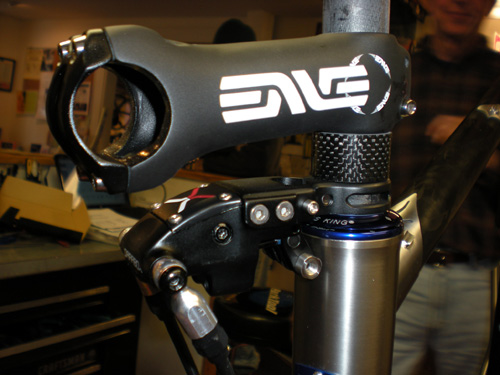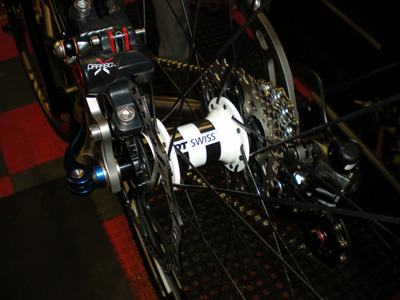Parabox Hydraulic Disc Brake Conversion
TRP PARABOX HYDRAULIC DISK BRAKE CONVERTER
By Jim Weaver, Service Manager, Fit Werx, VT
I just finished building a sweet new Seven Mudhoney Pro cross bike with disk brakes. The rider wanted hydraulic brakes, but also wanted to use a Campagnolo drivetrain. Considering there is not currently an integrated road shifter with hydraulic brake capabilities (SRAM will likely introduce one soon…), we used a converter that turns cable actuation into hydraulic lines – the TRP Parabox.
The Parabox conversion is fairly straight forward, the brake cable connects to the Parabox and the cable pulls on a lever that actuates the hydraulic piston. Until the big three (Shimano, SRAM, and Campagnolo) come out with road brakes that are compatible with hydraulics, the Parabox is one of the few viable alternatives that allows use of hydraulic disk brakes with conventional drop bar shifter/brake systems.
While the Parabox concept is straight forward, set-up is not. The Parabox comes with disks, calipers and hoses – everything needed to install the system. The Parabox converter itself mounts on the fork steerer tube, just below the stem. In order to use the Parabox, you must have at least 17 mm of steerer tube between the top of the headset bearings and the stem. This is not an unusually large amount, but could be a problem for some riders who run very little spacer stack. There is very little clearance between this cable locking mechanism and the frame of the bike, so it is a bit tricky and tedious getting the cable the right length so that it can be locked in place, but doesn’t scratch the headtube of the frame. The hydraulic brake hoses had to be cut as they come sufficiently long to accommodate a wide variety of frame sizes. As with all hydraulic systems, cutting and reattaching the hoses often necessitates subsequent bleeding of the brakes. The Parabox kit came with everything needed to bleed the brakes, as well as new olives and related parts needed to attach the hoses to the Parabox unit. The bleeding process was quite simple, especially when compared to the procedures required by some other hydraulic systems.
Getting the brake lever “pull” adjusted was a bit tricky. There appears to be a set screw on each of the piston levers of the Parabox that could be used to adjust the amount of lever “pull”, but they are completely inaccessible once the Parabox is mounted on the bike… So, unless you want to pull the whole system off the fork to adjust the tension, the realistic adjustment is limited to in-line adjusters on the cable “noodles”. These work fine, but are limited in the amount of cable they can take up. This cable adjustment limitation is a major part of what makes set-up time consuming.
 So, the big question is, how does the system work? Once set-up properly, the Parabox works great. Lever modulation is good, and braking power is exceptional. The feel of the brakes is much better than that of mechanical disk brakes because there is no long brake cable to stretch and rub against housings and ferrules. If you know you want disc brakes, a bit bulky appearance and a time consuming initial set-up are the only true considerations. Like any disk system, the Parabox system weighs more than cantilever brakes. The Parabox unit weighs in at an advertised 497 grams, which is comparable to mechanical disk brakes. The benefit to the Parabox though is that is that they stop better than both mechanical disks or cantilever rim brakes and a lighter touch is needed than for cable-actuated disc brakes, as there is very little cable stretch loss. For cross racing and riding, where the weight is not the main concern, Parabox offers better braking than well set-up mechanical disk brakes and significantly better braking than cable actuated cantilevers. They also eliminate the problem of mud and debris build-up, so the Parabox makes a lot of sense on a cross bike.
So, the big question is, how does the system work? Once set-up properly, the Parabox works great. Lever modulation is good, and braking power is exceptional. The feel of the brakes is much better than that of mechanical disk brakes because there is no long brake cable to stretch and rub against housings and ferrules. If you know you want disc brakes, a bit bulky appearance and a time consuming initial set-up are the only true considerations. Like any disk system, the Parabox system weighs more than cantilever brakes. The Parabox unit weighs in at an advertised 497 grams, which is comparable to mechanical disk brakes. The benefit to the Parabox though is that is that they stop better than both mechanical disks or cantilever rim brakes and a lighter touch is needed than for cable-actuated disc brakes, as there is very little cable stretch loss. For cross racing and riding, where the weight is not the main concern, Parabox offers better braking than well set-up mechanical disk brakes and significantly better braking than cable actuated cantilevers. They also eliminate the problem of mud and debris build-up, so the Parabox makes a lot of sense on a cross bike.
There is a lot of talk about hydraulic disk brakes coming to road bikes as well and we could build a disc brake equipped road bike today with the Parabox mated up with 3T or ENVE’s road disk fork. Only time will tell though if disc brakes are truly an advance for road bikes for most riders and whether it becomes “the norm” in the future. What is unquestionable is that hydraulics, both on disks or calipers (see some discussion of the Magura hydraulics in our Cervelo P5 overview post), significantly enhances braking power and modulation. So, the choice is yours…



